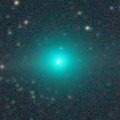
|
It passed near by the earth in late February, and it reached up to 4.9 mag (Feb. 23, Juan Jose Gonzalez). The coma extended up to 20 arcmin, and the anti-tail was clearly visible. Now it is fading rapidly. It has already faded down to 5.8 mag (Mar. 7, Alexandre Amorim). Because moving along the retrograde orbit, it will be lower rapidly in the evening sky. It will be too low to observe at 12 mag in late May.
Date(TT) R.A. (2000) Decl. Delta r Elong. m1 Best Time(A, h)
Mar. 7 8 29.27 18 29.6 0.582 1.480 138 6.2 21:23 (180, 36)
Mar. 14 7 35.79 20 57.3 0.792 1.541 118 7.1 20:05 (180, 34)
|

|
Brightening very rapidly, faster than expected. It is already so bright as 9.6 mag (Mar. 3, Juan Jose Gonzalez). It is expected to reach to 8 mag in 2009 summer. It becomes low tempporarily in February and March. But then it will be observable at 8-10 mag in good condition for a long time until late autumn.
Date(TT) R.A. (2000) Decl. Delta r Elong. m1 Best Time(A, h)
Mar. 7 22 34.02 34 40.1 4.027 3.341 40 9.7 4:25 (247,-32)
Mar. 14 22 37.67 34 20.0 4.025 3.318 39 9.6 4:32 (245,-26)
|

|
It brightened much faster than expected, and reached up to 8.4 mag (Jan. 30, Juan Jose Gonzalez). It was very large and visible through binoculars. It will be fading after this, but still bright as 8.9 mag (Mar. 2, Osamu Miyazaki). It keeps locating high in the evening sky for a while. It keeps higher than 40 degree until mid May when it fades down to 14 mag.
Date(TT) R.A. (2000) Decl. Delta r Elong. m1 Best Time(A, h)
Mar. 7 5 56.43 17 30.0 0.935 1.505 102 10.1 19:55 (163, 36)
Mar. 14 6 16.95 17 29.9 0.994 1.530 100 10.4 19:44 (164, 36)
|
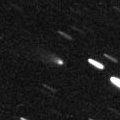
|
Brightening very rapidly, faster than expected. Now it is bright as 10.2 mag (Feb. 25, Juan Jose Gonzalez), already visible visually. It keeps 10-11 mag and observable in the evening sky for a long time until May.
Date(TT) R.A. (2000) Decl. Delta r Elong. m1 Best Time(A, h)
Mar. 7 2 1.97 14 10.4 1.696 1.249 46 11.2 19:55 (111, 5)
Mar. 14 2 27.31 16 51.9 1.713 1.258 46 11.0 19:44 (115, 5)
|

|
Now it is 12.3 mag, already visible visually (Mar. 3, Juan Jose Gonzalez). It will be bright at 9-10 mag for a long time from spring to autumn.
Date(TT) R.A. (2000) Decl. Delta r Elong. m1 Best Time(A, h)
Mar. 7 18 5.72 -19 10.1 1.735 1.764 75 11.7 4:25 (257, 51)
Mar. 14 18 25.17 -19 3.3 1.653 1.735 77 11.4 4:32 (253, 54)
|

|
It brightened up to 9.8 mag in December and January (Dec. 28, Juan Jose Gonzalez). Now it is fading, but still bright as 11.3 mag (Mar. 2, Osamu Miyazaki). It keeps visible visually for a long time until June when it becomes low in the evening at 13 mag.
Date(TT) R.A. (2000) Decl. Delta r Elong. m1 Best Time(A, h)
Mar. 7 6 14.16 40 34.5 2.641 3.062 105 11.5 19:55 (172, 14)
Mar. 14 6 20.51 39 8.5 2.770 3.106 100 11.7 19:44 (170, 15)
|
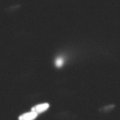
|
Already very bright as 11.3 mag (Mar. 6, Marco Goiato). It is expected to brighten up to 10 mag from late 2009 to early 2010. Good condition in the Southern Hemisphere. In the Northern Hemisphere, it is observable in the evening low sky from February to April. Then it becomes unobservable until September. But after October, it is observable at 10 mag for a while in good condition. In the Southern Hemisphere, it keeps observable for a long time while brightening until June when it brightens to 11 mag. But it becomes unobservable around and after the brightest time.
Date(TT) R.A. (2000) Decl. Delta r Elong. m1 Best Time(A, h)
Mar. 7 5 20.53 -37 2.8 3.131 3.265 88 11.9 19:55 ( 77, 71)
Mar. 14 5 24.90 -34 36.8 3.121 3.213 86 11.8 19:44 ( 84, 68)
|

|
Now it brightened up to 11.3 mag (Feb. 25, Juan Jose Gonzalez). It will reach to 10-11 mag in June. In the Northern Hemisphere, it keeps observable in good condition until May when it becomes brightest. But it will never be observable again after that. In the Southern Hemisphere, it is not observable until April. But after that, it will be observable while fading gradually.
Date(TT) R.A. (2000) Decl. Delta r Elong. m1 Best Time(A, h)
Mar. 7 3 50.50 55 39.6 1.734 1.897 83 12.5 19:55 (156, -9)
Mar. 14 4 9.06 52 14.3 1.728 1.823 79 12.3 19:44 (154, -6)
|
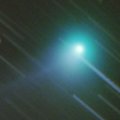
|
It reached to 6.3 mag in September in the southern sky (Sept. 4, Marco Goiato). It was bright at 10.0 mag still on Jan. 13 (U. Pilz). However, no visual observations have been reported since that. It keeps observable in the northern sky while fading gradually. In the Southern Hemisphere, it will never be observable again.
Date(TT) R.A. (2000) Decl. Delta r Elong. m1 Best Time(A, h)
Mar. 7 21 3.80 50 53.5 2.883 2.579 62 12.5 4:25 (223,-23)
Mar. 14 21 19.06 53 49.6 2.955 2.660 63 12.7 4:32 (219,-22)
|

|
It brightened up to 11.5 mag in summer (Aug. 4, Marco Goiato). Although it is not observable in the Northern Hemisphere, it keeps observable in good condition for a long time in the Southern Hemisphere. However, no visual observations have been reported since last summer. Recent CCD observations suggest that it is still visible visually around 12-13 mag.
Date(TT) R.A. (2000) Decl. Delta r Elong. m1 Best Time(A, h)
Mar. 7 1 20.91 -71 20.6 3.092 2.891 69 12.6 19:55 ( 23, 35)
Mar. 14 1 58.09 -68 56.2 3.099 2.921 70 12.6 19:44 ( 26, 36)
|

|
Now it is very bright as 11.7 mag (Feb. 25, Juan Jose Gonzalez). It keeps observable in good condition until May, then it keeps observable until July when it becomes too low in the evening sky, around 12-13 mag for a long time.
Date(TT) R.A. (2000) Decl. Delta r Elong. m1 Best Time(A, h)
Mar. 7 9 25.47 20 1.6 1.453 2.368 150 12.8 22:24 (180, 35)
Mar. 14 9 21.83 20 2.4 1.479 2.350 142 12.7 21:53 (180, 35)
|

|
It reached to 10.9 mag in May (May 11, Marco Goiato). It is fading slowly. Now it is 13.9 mag (Feb. 14, Ken-ichi Kadota). It keeps bright as 13-14 mag for a long time after this until summer.
Date(TT) R.A. (2000) Decl. Delta r Elong. m1 Best Time(A, h)
Mar. 7 16 44.43 18 56.3 3.442 3.709 97 13.5 4:25 (203, 33)
Mar. 14 16 47.30 20 53.8 3.415 3.754 102 13.5 4:32 (194, 33)
|

|
Since the major outburst in last September, with a new outburst in December, it has been so bright as 10-11 mag for about half a year. Now it is still bright as 11.2 mag (Mar. 1, Marco Goiato).
Date(TT) R.A. (2000) Decl. Delta r Elong. m1 Best Time(A, h)
Mar. 7 7 41.42 23 38.2 5.466 6.111 126 13.6 20:40 (180, 31)
Mar. 14 7 40.43 23 33.4 5.562 6.113 119 13.6 20:12 (180, 31)
|

|
It was expected to reach up to 7 mag and to be observable in good condition in winter. But finally, the comet has never been recovered after all. This comet has not been observed since 1986. It was not detected, fainter than 20 mag on Dec. 1 (Takaaki Oribe). So it will be much fainter than expected, maybe already disappeared.
Date(TT) R.A. (2000) Decl. Delta r Elong. m1 Best Time(A, h)
Mar. 7 4 18.59 25 29.6 1.404 1.584 80 13.7 19:55 (143, 19)
Mar. 14 4 43.17 26 2.0 1.508 1.646 79 14.5 19:44 (145, 20)
|
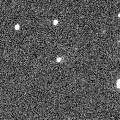
|
Now it is 13.4 mag and visible visually (Mar. 3, Juan Jose Gonzalez). It will brighten up to 12-13 mag in 2010 summer. In 2009, it keeps observable in good condition until summer.
Date(TT) R.A. (2000) Decl. Delta r Elong. m1 Best Time(A, h)
Mar. 7 12 31.23 11 57.4 2.237 3.183 158 14.6 1:33 (180, 43)
Mar. 14 12 26.61 12 32.4 2.194 3.161 163 14.5 1:01 (180, 43)
|

|
Now it is 13.9 mag (Feb. 7, Ken-ichi Kadota). It had been bright and visible visually around 13 mag from spring to autumn in 2008. It will be visible visually at 14 mag again until summer.
Date(TT) R.A. (2000) Decl. Delta r Elong. m1 Best Time(A, h)
Mar. 7 15 0.99 30 46.4 5.784 6.343 120 14.7 4:02 (180, 24)
Mar. 14 14 55.48 31 58.4 5.747 6.366 124 14.7 3:29 (180, 23)
|
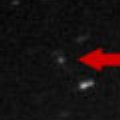
|
It had been observed until mid January in the evening low sky. It reached up to 14.1 mag (Jan. 11, Ken-ichi Kadota). Now it is not observable. It will be observable again in summer, but it will be fainter than 17 mag.
Date(TT) R.A. (2000) Decl. Delta r Elong. m1 Best Time(A, h)
Mar. 7 23 25.69 -3 23.9 2.807 1.819 4 14.9 19:55 ( 74,-16)
Mar. 14 23 43.66 -1 56.7 2.832 1.839 2 15.0 19:44 ( 75,-17)
|

|
Now it is visible visually at 14.4 mag (Feb. 26, Alan Hale). It will be observable at 15 mag in good condition in spring.
Date(TT) R.A. (2000) Decl. Delta r Elong. m1 Best Time(A, h)
Mar. 7 12 25.67 13 10.7 1.496 2.452 159 15.2 1:28 (180, 42)
Mar. 14 12 18.29 12 46.8 1.462 2.437 165 15.1 0:53 (180, 42)
|

|
It brightened up to 12.7 mag in 2008 spring (Apr. 12, Marco Goiato). But it faded down to 14.9 mag in July (July 22, Mitsunori Tsumura). No observations have been reported for a long time since last summer. But in the Southern Hemisphere, it has appeared in the morning sky, and it will be observable in good condition after this. It will never be observable again in the Northern Hemisphere.
Date(TT) R.A. (2000) Decl. Delta r Elong. m1 Best Time(A, h)
Mar. 7 19 8.32 -46 54.3 3.834 3.551 66 15.1 4:25 (304, 47)
Mar. 14 19 19.49 -47 23.2 3.790 3.588 70 15.1 4:32 (304, 51)
|
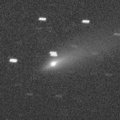
|
It reached up to 9.6 mag in summer (Aug. 2, Juan Jose Gonzalez). Now it is fading. It has already faded down to 15.3 mag (Feb. 27, Katsumi Yoshimoto). It keeps observable in good condition until June when it becomes fainter than 18 mag.
Date(TT) R.A. (2000) Decl. Delta r Elong. m1 Best Time(A, h)
Mar. 7 13 37.91 38 42.4 1.889 2.664 132 15.2 2:40 (180, 16)
Mar. 14 13 30.17 39 29.3 1.918 2.712 134 15.3 2:05 (180, 16)
|

|
Now it is 15.5 mag (Feb. 14, Catalina Sky Survey). It will be observable at 15-16 mag in good condition until spring.
Date(TT) R.A. (2000) Decl. Delta r Elong. m1 Best Time(A, h)
Mar. 7 9 9.94 24 35.7 2.732 3.593 145 15.3 22:08 (180, 30)
Mar. 14 9 7.11 24 41.2 2.790 3.590 137 15.3 21:38 (180, 30)
|

|
The condition of this return is bad, and it has not been observed yet. It will appear in the morning low sky at 13.5 mag in June. Then it will be getting higher gradually while fading slowly.
Date(TT) R.A. (2000) Decl. Delta r Elong. m1 Best Time(A, h)
Mar. 7 22 30.16 -6 10.1 2.770 1.801 9 15.5 4:25 (285,-10)
Mar. 14 22 47.40 -4 9.3 2.712 1.752 12 15.3 4:32 (280, -7)
|
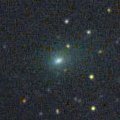
|
First return of a bright new periodic comet discovered by SOHO spacecraft in 2003. Now it was re-discovered by STEREO-B spacecraft. It reached up to 6-7 mag in the SOHO images in late December, then it was observed around 10 mag in the morning sky in early January. Now it is fading. It was bright as 12.5 mag still on Feb. 5 (Michael Jager), but it became fainter than 16 mag in early March by CCD observations. It keeps observable in good condition while fading gradually after this.
Date(TT) R.A. (2000) Decl. Delta r Elong. m1 Best Time(A, h)
Mar. 7 15 38.67 0 39.7 0.768 1.472 112 15.9 4:25 (186, 54)
Mar. 14 15 26.01 2 6.3 0.785 1.563 122 16.4 4:00 (180, 53)
|

|
Now it is 16.2 mag (Jan. 3, Ken-ichi Kadota). It should have reached up to 14.5 mag in summer in the southern sky, but it is already fading. It keeps observable while the comet will be fading slowly after this.
Date(TT) R.A. (2000) Decl. Delta r Elong. m1 Best Time(A, h)
Mar. 7 11 47.72 -15 50.3 2.862 3.795 156 16.1 0:50 (180, 71)
Mar. 14 11 41.30 -13 41.5 2.882 3.846 163 16.2 0:16 (180, 69)
|
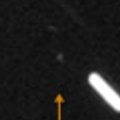
|
Brightened rapidly, and now it reached up to 16.5 mag (Feb. 28, E. Reina). It will be observable at 16.5 mag until April. It moves southwards very fast after early April, and will be unobservable very soon in the Northern Hemisphere.
Date(TT) R.A. (2000) Decl. Delta r Elong. m1 Best Time(A, h)
Mar. 7 17 8.52 72 39.2 0.355 1.084 95 16.3 4:25 (188,-19)
Mar. 14 18 27.92 68 32.7 0.328 1.034 87 16.2 4:32 (193,-17)
|

|
Now it is 16.8 mag (Feb. 21, Ken-ichi Kadota). It will be getting fainter and lower in the evening sky. It becomes unobservable in May.
Date(TT) R.A. (2000) Decl. Delta r Elong. m1 Best Time(A, h)
Mar. 7 3 32.02 26 20.0 2.487 2.356 70 16.4 19:55 (135, 12)
Mar. 14 3 45.29 26 36.3 2.563 2.356 66 16.5 19:44 (134, 11)
|
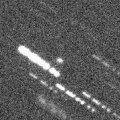
|
Now it is 16.9 mag (Feb. 17, Ken-ichi Kadota). It will be observable at 16.5 mag in good condition in 2009 spring.
Date(TT) R.A. (2000) Decl. Delta r Elong. m1 Best Time(A, h)
Mar. 7 17 19.09 28 57.1 2.855 3.033 90 16.8 4:25 (207, 21)
Mar. 14 17 10.49 30 22.5 2.767 3.049 96 16.8 4:32 (197, 23)
|
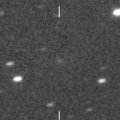
|
It must have been fainter than 18 mag, however, an outburst occured unexpectedly on Jan. 30 and it brightened up to 15.2 mag (Catalina Sky Survey). Then it faded rapidly, down to 18.6 mag on Feb. 19 (Leonid Elenin). However, another outburst occured on Feb. 20 and it brightened to 14.6 mag (Leonid Elenin). It was also visible visually at 13.5 mag (Feb. 22, Juan Jose Gonzalez). But it is fading rapidly after that. It has already faded down to 16.3 mag (Mar. 2, Leonid Elenin).
Date(TT) R.A. (2000) Decl. Delta r Elong. m1 Best Time(A, h)
Mar. 7 11 16.68 41 33.4 1.910 2.773 143 17.0 0:19 (180, 13)
Mar. 14 11 10.12 41 29.0 1.962 2.803 140 18.6 23:40 (180, 14)
|

|
Peculiar asteroid moving along a cometary orbit. It will be observable around 17 mag in good condition for a long time until May. It will fade out very rapidly after May.
Date(TT) R.A. (2000) Decl. Delta r Elong. m1 Best Time(A, h)
Mar. 7 14 42.01 -4 21.6 1.197 1.954 126 17.1 3:44 (180, 59)
Mar. 14 14 40.19 -4 12.3 1.181 2.000 133 17.0 3:14 (180, 59)
|

|
Now it is 18.2 mag (Mar. 1, W. Hasubick). It will be brightening rapidly after this, and will be 10 mag in autumn. It keeps observable for a long time until 2010 February. But in the Northern Hemisphere, it will be lower than 20 degree after July when it becomes about 13 mag, then it keeps very low all through the brightest time. It locates a bit higher in the Southern Hemisphere.
Date(TT) R.A. (2000) Decl. Delta r Elong. m1 Best Time(A, h)
Mar. 7 13 22.44 -3 7.8 1.618 2.502 145 17.4 2:24 (180, 58)
Mar. 14 13 19.05 -2 42.3 1.526 2.457 153 17.1 1:53 (180, 58)
|

|
It will reach to 17 mag in March. But it will fade out soon, and will be fainter than 18 mag in May.
Date(TT) R.A. (2000) Decl. Delta r Elong. m1 Best Time(A, h)
Mar. 7 13 8.51 -15 38.8 1.452 2.328 143 17.2 2:12 (180, 71)
Mar. 14 12 33.20 -14 23.4 1.378 2.329 157 17.1 1:09 (180, 70)
|

|
It will reach to 17 mag at opposition in March. But then it will fade out soon, and will be fainter than 18 mag in May.
Date(TT) R.A. (2000) Decl. Delta r Elong. m1 Best Time(A, h)
Mar. 7 12 11.19 -8 35.6 1.672 2.624 159 17.4 1:13 (180, 64)
Mar. 14 12 7.50 -8 13.0 1.635 2.613 166 17.2 0:42 (180, 63)
|

|
Brightening rapidly than expected. It reached up to 16.8 mag (Feb. 17, Yasukazu Ikari). It will be fading after this, and will be fainter than 18 mag in April.
Date(TT) R.A. (2000) Decl. Delta r Elong. m1 Best Time(A, h)
Mar. 7 9 52.40 10 38.6 0.727 1.694 160 17.2 22:51 (180, 44)
Mar. 14 9 51.30 9 42.4 0.766 1.712 153 17.3 22:22 (180, 45)
|

|
Now it is 17.4 mag (Feb. 21, Yasukazu Ikari). It will reach to 15 mag in 2010. It keeps observable for a long time after this in the Northern Hemisphere.
Date(TT) R.A. (2000) Decl. Delta r Elong. m1 Best Time(A, h)
Mar. 7 15 41.74 -4 55.4 5.927 6.357 111 17.4 4:25 (189, 60)
Mar. 14 15 41.83 -4 9.3 5.790 6.320 118 17.3 4:16 (180, 59)
|
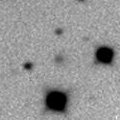
|
At the discovery in 2001, it became much brighter after the perihelion passage. In this apparition, although it was so faint as 20 mag in early September, it brightened very rapidly, and it reached up to 16.3 mag (Feb. 5, Ken-ichi Kadota). It keeps observable in good condition for a while after this. But it will fade out rapidly after this. It has already faded down to 17.6 mag (Feb. 21, Yasukazu Ikari). It will be fainter than 18 mag in April.
Date(TT) R.A. (2000) Decl. Delta r Elong. m1 Best Time(A, h)
Mar. 7 8 19.04 25 32.4 1.255 2.074 134 17.3 21:18 (180, 29)
Mar. 14 8 22.28 25 30.4 1.329 2.095 128 17.5 20:54 (180, 30)
|

|
It keeps observable at 17.5 mag until spring. But it locates low in the Northern Hemispere.
Date(TT) R.A. (2000) Decl. Delta r Elong. m1 Best Time(A, h)
Mar. 7 8 16.13 -23 51.4 3.758 4.444 128 17.4 21:14 (180, 79)
Mar. 14 8 14.25 -23 25.0 3.808 4.447 124 17.4 20:45 (180, 78)
|
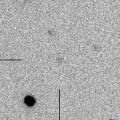
|
It was observed at 18 mag from autumn to winter in 2007. It will be observable again at 18 mag from winter to spring in 2009.
Date(TT) R.A. (2000) Decl. Delta r Elong. m1 Best Time(A, h)
Mar. 7 10 25.76 -5 59.4 4.677 5.638 164 17.9 23:24 (180, 61)
Mar. 14 10 22.97 -5 48.9 4.700 5.645 159 17.9 22:53 (180, 61)
|
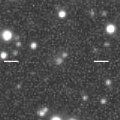
|
Now it is 17.6 mag (Jan. 10, Ken-ichi Kadota). It keeps observable in good condition at 17.5-18 mag until March.
Date(TT) R.A. (2000) Decl. Delta r Elong. m1 Best Time(A, h)
Mar. 7 5 12.75 17 40.0 2.142 2.396 92 17.9 19:55 (151, 32)
Mar. 14 5 20.60 18 44.4 2.220 2.389 87 18.0 19:44 (149, 30)
|

|
Great outburst occured in 2007 October, and it bacame a naked eye comet of 2 mag. It kept so bright as 5.5 mag still in 2008 spring (Apr. 30, Carlos Labordena), but it was extremely faint and difficult to see. The size was so large, the diameter was larger than 60 arcmin. Now it became observable in good condition again. The extremely faint large diffuse glow may be detected with a best sky condition, around 5-6 mag with a diameter of 1 or 2 degrees. Mitsunori Tsumura detected a possible glow of Comet Holmes on Nov. 4. Current brightness of the central core is 17.7 mag (Feb. 13, Catalina Sky Survey), much brighter than pre-outburst brightness still now.
Date(TT) R.A. (2000) Decl. Delta r Elong. m1 Best Time(A, h)
Mar. 7 8 21.02 26 20.7 3.603 4.357 134 19.1 21:19 (180, 29)
Mar. 14 8 18.36 26 5.5 3.704 4.377 127 19.2 20:49 (180, 29)
|

|
It was observed bright at 16.5-17 mag from late 2006 to early 2007. However, it is fading after that, although it is getting closer to the sun. It was so faint as 19.4 mag around the perihelion passage in 2008 spring (Mar. 10, Mitsunori Tsumura). This comet was observed so faint around the perihelion passage in the previous apparition at the discovery. It faded out before the perihelion passage again in this apparition. No observations have been reported since 2008 April at all.
Date(TT) R.A. (2000) Decl. Delta r Elong. m1 Best Time(A, h)
Mar. 7 11 39.59 23 22.0 3.443 4.392 160 21.7 0:42 (180, 32)
Mar. 14 11 35.91 23 50.3 3.458 4.400 158 21.8 0:11 (180, 31)
|
|
![]()
 C/2006 OF2 ( Broughton )
C/2006 OF2 ( Broughton ) C/2007 Q3 ( Siding Spring )
C/2007 Q3 ( Siding Spring ) C/2008 T2 ( Cardinal )
C/2008 T2 ( Cardinal ) C/2008 A1 ( McNaught )
C/2008 A1 ( McNaught ) C/2007 G1 ( LINEAR )
C/2007 G1 ( LINEAR ) 116P/Wild 4
116P/Wild 4 C/2006 Q1 ( McNaught )
C/2006 Q1 ( McNaught ) 29P/Schwassmann-Wachmann 1
29P/Schwassmann-Wachmann 1 85P/Boethin
85P/Boethin 65P/Gunn
65P/Gunn C/2005 L3 ( McNaught )
C/2005 L3 ( McNaught ) 68P/Klemola
68P/Klemola 77P/Longmore
77P/Longmore C/2007 B2 ( Skiff )
C/2007 B2 ( Skiff ) 19P/Borrelly
19P/Borrelly 74P/Smirnova-Chernykh
74P/Smirnova-Chernykh 64P/Swift-Gehrels
64P/Swift-Gehrels 210P/2008 X4 ( Christensen )
210P/2008 X4 ( Christensen ) C/2006 U6 ( Spacewatch )
C/2006 U6 ( Spacewatch ) 209P/2008 X2 ( LINEAR )
209P/2008 X2 ( LINEAR ) 59P/Kearns-Kwee
59P/Kearns-Kwee C/2008 Q1 ( Maticic )
C/2008 Q1 ( Maticic ) 33P/Daniel
33P/Daniel 2001 TX16
2001 TX16 88P/Howell
88P/Howell C/2009 B2 ( LINEAR )
C/2009 B2 ( LINEAR ) 143P/Kowal-Mrkos
143P/Kowal-Mrkos P/2008 Y2 ( Gibbs )
P/2008 Y2 ( Gibbs ) C/2008 FK75 ( Lemmon-Siding Spring )
C/2008 FK75 ( Lemmon-Siding Spring ) 204P/2008 R5 ( LINEAR-NEAT )
204P/2008 R5 ( LINEAR-NEAT ) P/2008 Y3 ( McNaught )
P/2008 Y3 ( McNaught ) C/2007 S2 ( Lemmon )
C/2007 S2 ( Lemmon ) 211P/2008 X1 ( Hill )
211P/2008 X1 ( Hill ) 17P/Holmes
17P/Holmes 173P/2005 T1 ( Mueller 5 )
173P/2005 T1 ( Mueller 5 )![]()




























